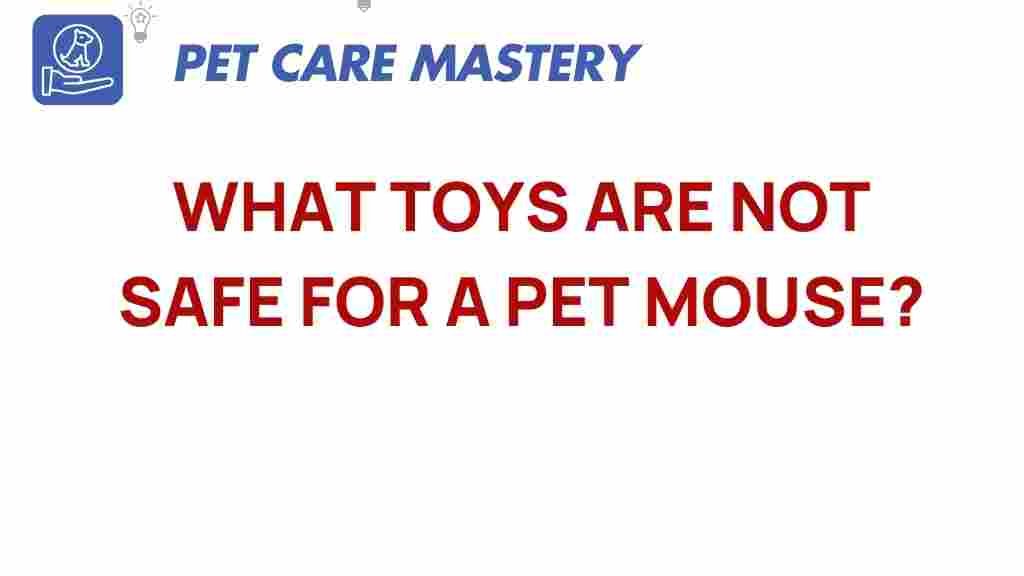Pet Mouse Safety: Unpacking the Dangers
When it comes to caring for a pet mouse, ensuring their safety is a top priority for every responsible pet owner. One aspect of pet mouse safety that often gets overlooked is the toys that we provide for them. While toys can enhance your pet mouse’s environment, not all toys are created equal. In this article, we will delve into the various types of toys that may pose dangers to your pet mouse and how to choose safe alternatives.
Understanding the Risks of Unsafe Toys
Pet mice are curious creatures, and they love to explore their environment. However, certain toys can lead to serious health issues or even fatal accidents. Here are some common risks associated with unsafe toys:
- Choking Hazards: Small parts can break off and pose a choking risk.
- Toxic Materials: Some toys are made from materials that are harmful if ingested.
- Sharp Edges: Toys with sharp edges can cause cuts or injuries.
- Stuck Limbs: Toys that allow limbs to get stuck can lead to serious injuries.
- Overheating: Some plastic toys can trap heat, leading to overheating.
Common Types of Unsafe Toys
To help you better understand what to avoid, we’ve categorized common types of unsafe toys for your pet mouse:
1. Plastic Toys
While many plastic toys are marketed as safe, not all are suitable for pet mice. Here are some considerations:
- Non-Pet Safe Plastic: Some plastics contain harmful chemicals like BPA, which can be toxic.
- Small Parts: Toys with parts that can be chewed off and swallowed should be avoided.
2. Wooden Toys
Wooden toys can be a great option, but they come with their own set of risks:
- Paint and Stains: Ensure that any paint used is pet-safe. Toxic wood finishes can harm your mouse.
- Splintering: Choose sturdy wood that won’t splinter easily, as splinters can cause injuries.
3. Stuffed Animals and Fabric Toys
While cuddly, stuffed toys can pose issues:
- Loose Threads: Threads can become choking hazards if detached.
- Filling Material: If your mouse chews through, the filling could be harmful if ingested.
4. Balls and Accessories
Exercise balls and similar accessories can provide entertainment, but they may not always be safe:
- Size Issues: Ensure that the ball is the right size for your mouse to prevent getting stuck.
- Ventilation: Lack of ventilation can lead to overheating.
Choosing Safe Toys for Your Pet Mouse
To promote pet mouse safety, it’s essential to choose toys made specifically for small rodents. Here are some tips for selecting safe toys:
- Check for Labels: Look for toys labeled as safe for small animals.
- Material Matters: Opt for natural materials like untreated wood, paper, or safe plastics.
- Size Appropriateness: Ensure the toy is appropriately sized for your mouse, preventing choking hazards.
- Inspect Regularly: Check toys frequently for wear and tear, replacing them as necessary.
Step-by-Step Guide to Creating a Safe Toy Environment
Here’s a simple guide on how to create a safe environment for your pet mouse with toys:
- Research: Spend time researching which toys are safe for pet mice.
- Purchase Wisely: Buy toys from reputable sources that specialize in small animal products.
- Test for Safety: Before introducing any new toy, examine it for potential dangers.
- Rotate Toys: Keep your pet mouse engaged by rotating their toys regularly.
- Monitor Playtime: Observe your mouse when they play to ensure they aren’t encountering any hazards.
Troubleshooting Common Issues
Even with careful planning, issues may arise when it comes to pet mouse safety. Here are some troubleshooting tips:
- If Your Mouse Is Chewing: Provide more chew-friendly options to redirect their energy.
- If Toys Are Damaged: Remove damaged toys immediately to prevent accidents.
- If Your Mouse Is Injured: Contact a veterinarian right away if you notice any injuries related to toys.
Conclusion
Ensuring pet mouse safety is an ongoing responsibility that extends to the toys you provide. By understanding the dangers associated with various types of toys and making informed choices, you can create a safe and stimulating environment for your furry friend. Always prioritize safety over aesthetics when selecting toys, and don’t hesitate to consult resources such as pet care websites and professionals for guidance. Your pet mouse will thank you with their playful antics and happy demeanor!
For more information on pet mouse care, check out our comprehensive guide to keeping your mouse safe and healthy.
This article is in the category Behavior and created by PetCareMastery Team
